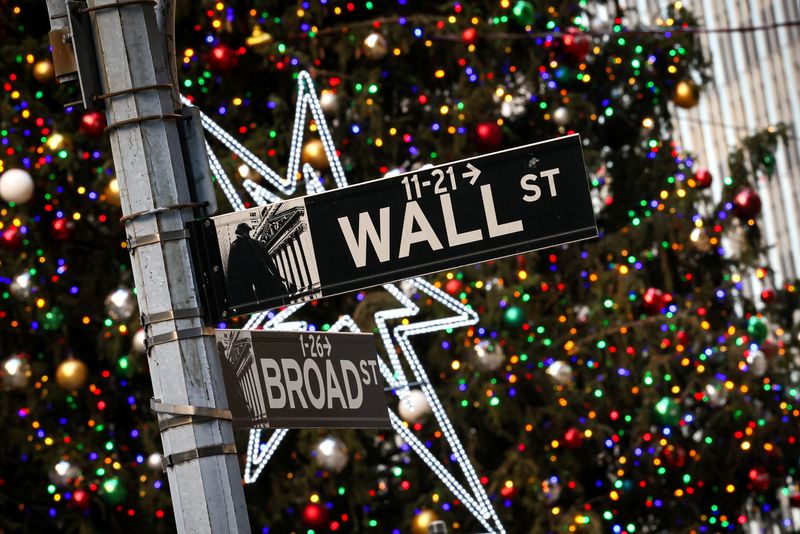By David Randall
NEW YORK (Reuters) -A surge in U.S. government bonds has helped lift stocks and heightened investors’ appetite for risk. Now some are betting that further gains may be harder to come by unless the economy severely weakens, potentially upsetting the narrative of resilient growth that has propelled markets.
An unexpected dovish pivot from the Federal Reserve earlier this week turbocharged the rally in Treasuries, sending benchmark 10-year yields to their lowest level since July. Yields, which move inversely to bond prices, now stand at 3.93%, some 110 basis points from a 16-year high hit in October.
The tumble in Treasury yields has rippled far beyond the bond market as it pulled down rates on mortgages, eased financial conditions and pushed investors into stocks and other risky investments. The S&P 500 is up nearly 15% since its October lows and has risen nearly 23% this year, putting it within striking distance of a record high.
Some investors, however, believe much of the dovish shift from the Fed may already be reflected in Treasury prices. Deeper cuts, they say, would be more likely if a rapidly slowing economy forced the Fed to accelerate its easing - an outcome that would run counter to the “soft landing” outlook that has buoyed stocks in recent months.
"The market is pretty perfectly priced for a soft landing," said Stephen Bartolini, said lead portfolio manager of the U.S. Core Bond Strategy at T. Rowe Price. "The bulk of the move lower is complete and if we were to push yields from here it would have to be due to expectations that the economy is slipping into recession."
The Fed’s new projections - published on Wednesday - pencil in a median 75 basis points of cuts next year, taking the fed funds rate to between 4.50% and 4.75%. Traders, by contrast, are betting rates will fall by 150 basis points, according to data from LSEG.
Technical factors may also make it more difficult for the bond rally to sustain itself. The swift move will likely prompt some profit-taking on the part of investors due to concerns that the trade is overcrowded, strategists at BofA Global Research said in a note Friday.
Some Fed officials have begun pushing back against the view that a pivot is imminent. New York Fed President John Williams on Friday said the U.S. central bank is still focused on whether it has monetary policy on the right path to continue bringing inflation back to its 2% target.
“We have seen the easy money on this Fed pivot already made," said James Koutoulas, chief executive officer at Typhon Capital management, who believes further gains in Treasuries may require a growth scare that sparks a scramble for safe assets. "We expect to chop around a bit in the front of the curve until the economy materially weakens further.”
Investors will be watching economic data next week, including personal consumption expenditures and initial jobless claims that may sway the Fed's outlook for inflation.
A soft landing, in which growth remains resilient while inflation slows towards the Fed’s target rate, has become the base case scenario for Wall Street firms, including BMO Capital Markets and Oppenheimer Asset Management. The firms see the S&P 500 at 5,100 and 5,200 next year, respectively, compared to its current level of 4719.
Some investors believe yields will continue to fall. Jack McIntyre, portfolio manager for Brandywine Global, said the week’s rapid drop in yields was likely aided by bearish investors unwinding their bets after being caught off guard by the Fed’s pivot.
Short bets against two-year Treasuries hit record levels earlier this month, data from the Commodity Futures Trading Commission showed.
Though yields might pare some of that move in the near-term, McIntyre expects the decline to resume as inflation cools, with the 10-year settling between 3.5% and 3.7% in the middle of next year.
Arthur Laffer Jr., president of Laffer Tengler Investments, is less bullish on government bonds. The swift decline in yields is already loosening financial conditions, potentially making it more difficult for the Fed to cut rates next year without risking a snapback in inflation, he said.

Laffer pointed to data such as the Atlanta Fed's GDPNow estimate, which shows fourth quarter GDP rising by 2.6%, more than one percentage point higher than in mid-November.
The rally "is overdone and the market has moved too fast," he said.